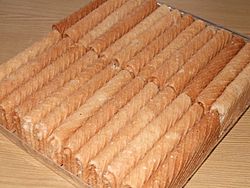Kue semprong facts for kids

A box of kue semprong
|
|
| Alternative names | Sapit, sepit, kapit, gulong, kue Belanda |
|---|---|
| Type | Wafer, kue |
| Course | Snack |
| Place of origin | Indonesia |
| Region or state | Throughout Indonesia, Malaysia, Brunei, Singapore |
| Main ingredients | Rice flour, granulated sugar, coconut milk, eggs, cooking oil |
Kue semprong is a yummy traditional snack from Indonesia. It's also known by other names like Asian egg roll, sapit, sepit, kue Belanda, or kapit. In English, some people call them Love letters.
This crispy wafer is made by cooking a special egg batter. The batter is pressed between two hot iron molds. These molds are often heated over a charcoal stove. You can find kue semprong in many countries. These include Indonesia, Malaysia, Singapore, and Brunei.
The special iron molds have two plates. These plates are pressed tightly together. They also have long handles. This helps people hold them over the hot stove. The molds can be flat or have cool patterns. Some molds have pictures of animals. These include fish, roosters, and snails. These designs make the snack look pretty. They can also bring good luck!
What are the Different Shapes?
In the Indonesian language, the word semprong means "tube" or "roll". The word sepit comes from jepit, which means "clip". Both semprong and sepit are very similar wafers. The main difference is their shape.
- The roll-shaped wafer is called semprong. It looks like a hollow tube.
- The triangular-folded wafer is called sepit. It is folded into a triangle.
In Malaysia and Brunei, both shapes are often called sapit or sepit. Traditional kue semprong are usually hollow inside. But newer versions might have fillings. These can include yummy chocolate or cheese.
Where Did Kue Semprong Come From?
Kue semprong shows a link between Indonesia and the Netherlands. This connection comes from the time when the Netherlands ruled Indonesia. Many people believe this snack came from Dutch egg roll wafers.
The word Belanda means "Dutch" in the Malay language. This name hints at the snack's Dutch beginnings. The Dutch have many types of biscuits. Some of these are thin wafers. They are very similar to Kuih Belanda or Kuih Kapit.
Many cooking methods for biscuits and cakes were shared. The Dutch, English, and Portuguese taught these to the Malay people. These tasty biscuits might have traveled to parts of Malaysia and Singapore. They may have arrived from Penang and Malacca. This happened through the Peranakan Chinese people. They didn't know the Dutch snack's original name. So, they simply called it kuih Belanda or kuih kapit.

